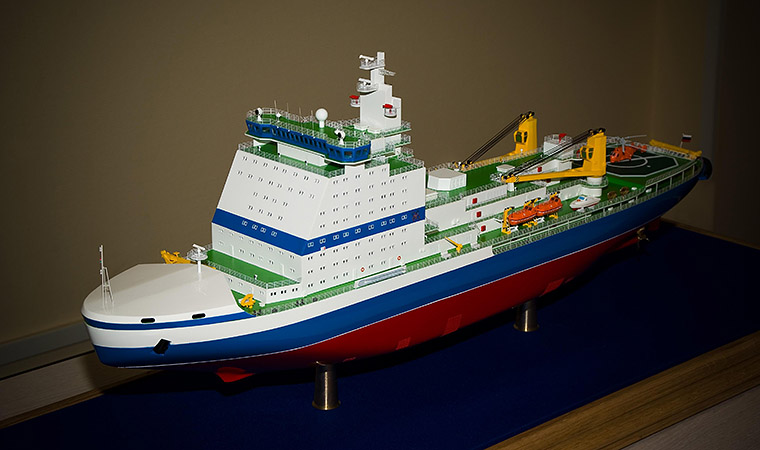
Sibir Icebreaker to Float Out Soon
back to contentsSibir is one of Project 22220 icebreakers designed to reinforce Russia’s leadership in the Arctic. Capable of breaking three meter thick ice, these vessels will escort ship convoys through the Arctic Ocean. They will assist oil tankers and gas carriers in transporting hydrocarbons from the Yamal and Gydan Peninsulas and Kara Sea offshore deposits to the Asian-Pacific markets.
The double-draft design allows for the operation both in Arctic deep waters and estuaries of polar rivers. The Project 22220 vessels will be powered by two nuclear reactors, with the 175 MW RITM-200 propulsion unit acting as a primary source of steam. They will become the world’s largest and most powerful (60 MW) nuclear icebreakers. All Project 22220 vessels will measure 173.3 meters in length and 34 meters in width, displace 33,500 tons of water and have a crew of 75 people.
A few days ago, ZiO-Podolsk (a subsidiary of AEM, Rosatom’s mechanical engineering division) finished hydraulic tests on the first reactor vessel to be used in Sibir’s RITM-200 propulsion unit. Being the final step of the reactor vessel production process, the tests serve to confirm the product quality and provide a guarantee of seamless operation in future.
Hydraulic tests are one of the most frequent quality control procedures used to check whether equipment working under pressure is hermetically sealed. The reactor vessel was tested by inducing internal condensation under the air pressure of 270 atmospheres. After the pressure fell to 220 atmospheres, experts examined the vessel for deformations and leaks by exposing it to UV radiation and using luminescent detection techniques. The results confirmed robustness and reliability of the reactor.
INTERESTING FACTS
A short time ago, 50 Let Pobedy, another Russian icebreaker, set a speed record en route from Murmansk to the North Pole. The journey to the North Pole was dedicated to the 40th anniversary of the first voyage to reach the northernmost point of the globe. The nuclear-powered ship left Murmansk and reached the North Pole in just 79 hours. In 1977, it took the icebreaker 176 hours to get to the peak of the planet. The voyage of 50 Let Pobedy was the 124th in the history of sea journeys to the North Pole, 111 of which were done by Russian and Soviet vessels.
At present, the plant is preparing to run a fit-up test on RITM-200’s vessel and internals. The service life of the new reactor is 40 years.
The first RITM-200 reactor was manufactured at ZiO-Podolsk for the flagship Arktika nuclear icebreaker in 2016. It is expected to be fully commissioned in 2019, said Rosatomflot’s CEO Vyacheslav Ruksha at the Arctic Council Ministerial Meeting. He also said that the design of the Lider (Leader) icebreaker and relevant ice tests would be completed by the end of the year. The icebreaker will be capable of making its way through the ice at a speed of 12–14 knots.




